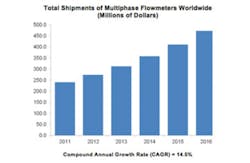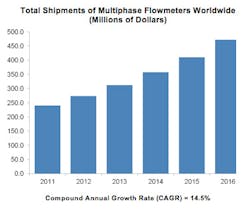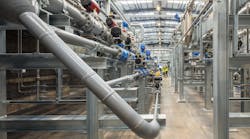Multiphase flowmeters are used in oil & gas production to determine the mixture and amount of oil, gas and water coming out of the well. This measurement used to only be possible after the fluids were physically separated. Multiphase flow measurement gained significance when the prospective decline in production of the North Sea oil fields made it necessary to find a way to analyze the increasing amounts of gas and water that were becoming a greater part of the fluid from the wells. Several research projects were undertaken at that time to develop multiphase technology that could provide this analysis on fluids as they came out of the wells. Much of the research still centers in areas near the North Sea, and many companies offering multiphase flowmeters are international.
Norway has become a center of product and development for multiphase and ultrasonic flowmeters because of the presence of Christian Michelsen Research (CMR, www.cmr.no), located in Bergen. The Christian Michelsen Institute did the research from 1982 to 1985 to create the Fluenta flare gas meter, and in 1985 founded Fluenta (www.fluenta.com), which is still a supplier of ultrasonic flare gas meters.
Today a number of multiphase companies call Norway home, including Roxar (Stavenger), Multi Phase Meter (MPM) (Stavenger), Framo Engineering (Bergen), and Abbon (Rud).
Multiphase technology promises significant benefits to well operators. However, these complex instruments combine multiple technologies and therefore demand that the operator be well-versed in the physics of the instrument in addition to its construction, installation, and use. The reduced number of trained engineers familiar with flow and flow technologies is a serious concern to multiphase flowmeter suppliers, as the field performance of multiphase devices is so dependent on the operators’ adaptability and their ability to configure the instrument within a dynamic application.
Multiphase flowmeters offer multiple advantages:
- They reduce the need for hardware installed on topside (onshore), offshore, and subsea applications. Because they reduce or eliminate the need for dedicated test separators by measuring flow at the wellhead, multiphase meters save on platform space and make it possible to drill with a smaller equipment footprint.
- Multiphase flowmeters make it unnecessary to individually test the performance of each individual well, since the data from a multiphase meter can provide similar data. This is especially important for subsea applications where the well testing flowlines can be especially long. Multiphase meters can reduce or eliminate the need for separate well-testing lines.
- Multiphase meters provide important data about the well itself. Changes in the gas/oil ratio can be detected more quickly in a real-time basis, while test separators provide slower response with fewer data points.
- Multiphase meters are useful for allocation metering situations, where the produced fluids must be commingled and sent to a processing facility. Without multiphase meters, the fluid from each well has to be sent through a test separator before being sent to the processing facility.
Multiphase flowmeter technology is only about 30 years old. It has received mixed reviews from end-users, mainly because it is a difficult and complex technology that has yet to be perfected. Look for suppliers to continue to work to improve their multiphase flowmeters, which are very much in demand by oil and gas producers. Their adoption rate will increase along with improvements in the technology.
Jesse Yoder, Ph.D., is president of Flow Research Inc. in Wakefield, Mass., a company he founded in 1998. He has 25 years of experience as an analyst and writer in process control. Dr. Yoder specializes in flowmeters and other field devices, including pressure and temperature products. Dr. Yoder can be reached at [email protected].
For more research information on multiphase flowmeters, visit FlowMultiphase.com.
Flow Research recently published the latest update of its “Volume X: The World Market for Flowmeters” study, highlighting application and technology trends in flow measurement worldwide. For more details on this study, visit FlowEverything.com.



